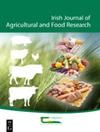Yield response of field beans (Vicia faba) to plant population and sowing date in a temperate climate
IF 1.4
4区 农林科学
Q3 AGRICULTURE, MULTIDISCIPLINARY
引用次数: 0
Abstract
Sowing date and seed rate influence crop establishment, growth, yield and profitability. The growth and yield of field beans (Vicia faba) in response to sowing date and seed rate was examined over three seasons, 2016–2019, in Teagasc, Oak Park, Carlow, Ireland. Early winter sowings (October) established better than late winter sowings in November and January. No significant difference was found in establishment from mid-February to mid-March. Yield was generally highest from October sowings for the winter cultivar. Yields were similar from February, March and April sowings for the spring cultivar, with March generally yielding higher across the three seasons. Yield was also found to increase significantly with seed rate for both winter and spring cultivars. The economic optimum plant population was estimated for the October and March sowing dates, by fitting a standard (linear + exponential) curve. There is no published information on the optimum plant populations for field beans in Ireland and we believe we are the first to report these findings. The estimated economic optimum plant populations varied between 13 and 38 plants/m2 for both varieties, with an average optimum of 25.5 plants/m2. This range falls within the current recommendations for sowing field beans in Ireland, demonstrating that increasing plant populations above the current commercial practice for field beans in Ireland, will not increase yield or profitability.温带条件下菜豆产量对种群和播期的响应
播期和播种率影响作物成活率、生长、产量和盈利能力。在爱尔兰卡洛橡树园的Teagasc,研究了2016-2019年三个季节中,大田蚕豆(Vicia faba)的生长和产量对播种日期和种子率的响应。早冬播种(10月)比晚冬播种(11月和1月)建立得更好。2月中旬至3月中旬,建成度无显著差异。冬季品种的产量一般在10月播种时最高。春季品种的产量与2月、3月和4月的播种量相似,3月的产量通常在三个季节中较高。冬季和春季品种的产量也随着种子率的增加而显著增加。通过拟合标准(线性+指数)曲线估计了10月和3月播期的经济最优种群。目前还没有关于爱尔兰大田豆类最佳植物种群的公开信息,我们相信我们是第一个报告这些发现的人。两个品种的经济最优种群数在13 ~ 38株/m2之间,平均最优种群数为25.5株/m2。这一范围属于爱尔兰目前推荐的大田大豆播种范围,这表明在爱尔兰大田大豆目前的商业实践基础上增加植物种群数量不会增加产量或盈利能力。
本文章由计算机程序翻译,如有差异,请以英文原文为准。
求助全文
约1分钟内获得全文
求助全文
来源期刊
CiteScore
2.50
自引率
20.00%
发文量
23
审稿时长
>36 weeks
期刊介绍:
The Irish Journal of Agricultural and Food Research is a peer reviewed open access scientific journal published by Teagasc (Agriculture and Food Development Authority, Ireland). Manuscripts on any aspect of research of direct relevance to Irish agriculture and food production, including plant and animal sciences, food science, agri environmental science, soils, engineering, buildings, economics and sociology, will be considered for publication. The work must demonstrate novelty and relevance to the field of research. Papers published or offered for publication elsewhere will not be considered, but the publication of an abstract does not preclude the publication of the full paper in this journal.

 求助内容:
求助内容: 应助结果提醒方式:
应助结果提醒方式:


